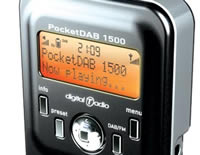 We’re big fans of Pure Digital and their seemingly endless mission to push the features and functions of DAB radios. Their latest move is to launch a new portable DAB radio.
We’re big fans of Pure Digital and their seemingly endless mission to push the features and functions of DAB radios. Their latest move is to launch a new portable DAB radio.
Launching DAB on the world with the attention-grabbing BUG radio designed by cardigan-wearing, ex-shoe designer, Wayne Hemingway (which they recently updated), they’ve followed it up with numerous diverse models.
True to their innovating inclinations, Pure has been selling their PocketDAB 1000 radio successfully for some time, but not content to rest on their laurels, have taken the chance to improve on their success by launching a new, improved (as they say in the washing powder ads) version, the PocketDAB 1500 – and at a lower price than its predecessor.
They added FM with RDS, textSCAN, a striking black anodised aluminum case and a ChargePAK rechargeable battery pack. Not content with adding features, they’ve managed to reduce the weight to the little fellow to 123g, making it their lightest so far.
To ensure this beauty has enough power for 24 hours of constant listening, the set is recharged by plugging it into the mains electricity to juice up the ChargePAK battery.
You could well be asking what the hell textSCAN is? Let us enlighten you. One of the features of DAB is the ability of the broadcaster to have text scroll on the displays of the receiver. textSCAN give the listener control over this text, so it’s not lost as it scrolls off the screen.
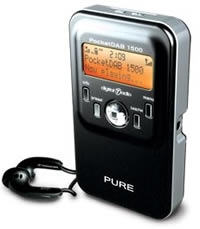 Recognising that what they’re selling is audio quality, Pure have done a deal with Sennheiser to have Sennheiser’s MX300 headphones included in the package.
Recognising that what they’re selling is audio quality, Pure have done a deal with Sennheiser to have Sennheiser’s MX300 headphones included in the package.
Pure clearly think about the usability of their radios, which shows, giving features like automatically remembering the user’s ten most listened to stations in a favourites list.
DAB while on the move was, for a long time, a problem as the required signal strength is higher than analogue. Public perception of digital radio reception, or digitally reception generally is that it’s better quality. This can be true, but only when reception is sufficiently strong. Unlike analog reception, which will gently fade in and out, without the required minimum reception levels, digital can be a highly disturbing experience, with unpleasant, hard-edged choppiness hitting your ears.
This combined with the power-hungry design of the initial chipsets is the reason why we didn’t see truly portable DAB radio coming to market at the same time as the early mains-powered models.
The PocketDAB 1500 package can now be had in the shops for a RRP of £89.99, actually giving a price reduction on their previous model.
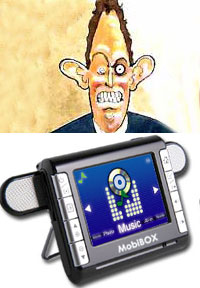 Smaller than a pack of cards and packed with enough whizz-bang functionality to keep a hyperactive cokehead entertained for hours, MobiBox’s new MP410 multimedia recorder and player packs a big punch for the price.
Smaller than a pack of cards and packed with enough whizz-bang functionality to keep a hyperactive cokehead entertained for hours, MobiBox’s new MP410 multimedia recorder and player packs a big punch for the price.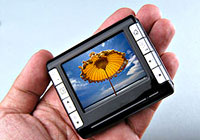 The MP410 also features a pair of folding out speakers for added ‘Tony Blair’ appeal, and comes with a pull-out stand for desk viewing.
The MP410 also features a pair of folding out speakers for added ‘Tony Blair’ appeal, and comes with a pull-out stand for desk viewing.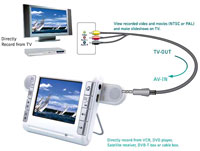 Interface 2 in 1 MiniUSB (USB 2.0/power in)
Interface 2 in 1 MiniUSB (USB 2.0/power in) Although in-ear bud headphones are all well and good for strutting down the street with your iPod/PDA/smartphone in your pocket, when it comes to DJing or listening at home, you might need something a little more substantial.
Although in-ear bud headphones are all well and good for strutting down the street with your iPod/PDA/smartphone in your pocket, when it comes to DJing or listening at home, you might need something a little more substantial.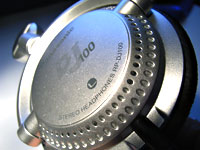 Designed for DJs
Designed for DJs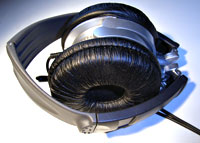 The sound
The sound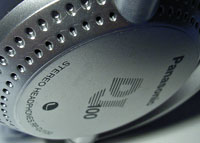 So after our own (paid for) headphones conked out after just four months and with no chance of a replacement after voiding our guarantee with the attempted emergency repair, we’ve had to rapidly downsize our enthusiasm.
So after our own (paid for) headphones conked out after just four months and with no chance of a replacement after voiding our guarantee with the attempted emergency repair, we’ve had to rapidly downsize our enthusiasm. More often than not, the in-ear headphones that come bundled with MP3 players are weedy affairs, producing a feeble floppy fart of a low end when you’re looking for a thunderous bass.
More often than not, the in-ear headphones that come bundled with MP3 players are weedy affairs, producing a feeble floppy fart of a low end when you’re looking for a thunderous bass. The human ear can only hear frequencies around 20 to 20,000 Hz, and that’s only when you’re young and healthy.
The human ear can only hear frequencies around 20 to 20,000 Hz, and that’s only when you’re young and healthy. This improved the sound no end, and the ‘phones are great for using on planes and trains when you want to hear as little exterior noise as possible and don’t fancy forking out for expensive noise cancelling units.
This improved the sound no end, and the ‘phones are great for using on planes and trains when you want to hear as little exterior noise as possible and don’t fancy forking out for expensive noise cancelling units.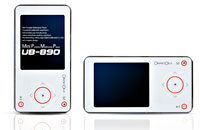 Lined up on the new product runway and awaiting clearance for take off is the slick looking Oracom UB890 portable media player.
Lined up on the new product runway and awaiting clearance for take off is the slick looking Oracom UB890 portable media player.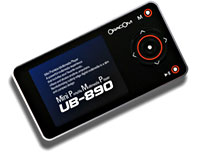 There’s also built in equaliser and 3D sound and onscreen visual effects to keep the easily-bored entertained.
There’s also built in equaliser and 3D sound and onscreen visual effects to keep the easily-bored entertained. Rounding off the gadget-fest, there’s also an alarm clock, sleep timer, built-in speakers (500mW + 500mW) and an iPod-esque ‘Touch Sensor Key Pad’ for shimmying through the menus.
Rounding off the gadget-fest, there’s also an alarm clock, sleep timer, built-in speakers (500mW + 500mW) and an iPod-esque ‘Touch Sensor Key Pad’ for shimmying through the menus.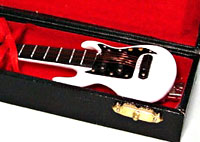 Straight out of the, “What’s The Chuffin’ Point Of That” Dept comes two utterly daft USB devices.
Straight out of the, “What’s The Chuffin’ Point Of That” Dept comes two utterly daft USB devices. But if you fancy indulging in a bit of micro air guitar work while carrying around a paltry amount of over-priced flash memory, point your credit card in the direction of geekstuff4u.com
But if you fancy indulging in a bit of micro air guitar work while carrying around a paltry amount of over-priced flash memory, point your credit card in the direction of geekstuff4u.com Underwater windows
Underwater windows We’re not sure at what depth the thing keeps on working or why anyone would want to be logging on to Windows in their Speedos, but there’s an English language version of the software available, and the whole sub-aqua caboodle could be yours for just €137.
We’re not sure at what depth the thing keeps on working or why anyone would want to be logging on to Windows in their Speedos, but there’s an English language version of the software available, and the whole sub-aqua caboodle could be yours for just €137.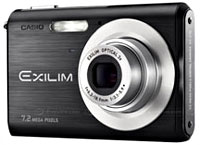 Casio have added the new Exilim Zoom EX-Z70 digital camera to their EXILIM range, ramping up the pixel count to a hefty 7.2 megapixels.
Casio have added the new Exilim Zoom EX-Z70 digital camera to their EXILIM range, ramping up the pixel count to a hefty 7.2 megapixels.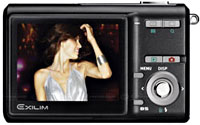 In an attempt to stave off the wobbles, Casio’s Anti Shake DSP is built in, although the anti-shake stuff is achieved through ramping up the ISO and dropping the image size, so it’s nowhere as good as proper optical image stabilisation.
In an attempt to stave off the wobbles, Casio’s Anti Shake DSP is built in, although the anti-shake stuff is achieved through ramping up the ISO and dropping the image size, so it’s nowhere as good as proper optical image stabilisation.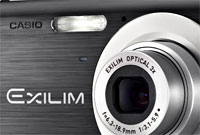 Available in “luxurious” black or high quality silver, the black EX-Z70 will be on the shelves from the beginning of July (you’ll have to wait a month for the silver version) for around £230 ($422, €335).
Available in “luxurious” black or high quality silver, the black EX-Z70 will be on the shelves from the beginning of July (you’ll have to wait a month for the silver version) for around £230 ($422, €335).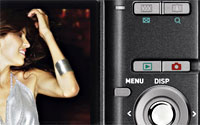 Contrast type AF (selectable between spot, multi)
Contrast type AF (selectable between spot, multi)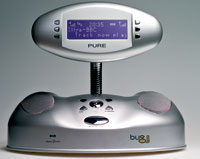 It might look like a weird mutation between Dr Who’s K9 and and the wobbly robot from Lost In Space, but we like the fact that PURE Digital’s new Bug TOO DAB radio is brave enough to stand out from the current crowd of wood’n’plastic identikit DAB radios.
It might look like a weird mutation between Dr Who’s K9 and and the wobbly robot from Lost In Space, but we like the fact that PURE Digital’s new Bug TOO DAB radio is brave enough to stand out from the current crowd of wood’n’plastic identikit DAB radios.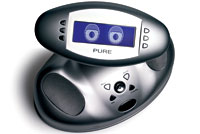 This usefully displays artists names, song titles, news, sports results and other information, with the EPG feature offering programme information and schedules.
This usefully displays artists names, song titles, news, sports results and other information, with the EPG feature offering programme information and schedules.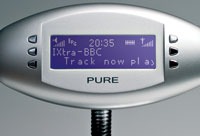 There’s also alarm, sleep and timer record functions – including an MP3 alarm – so the Bug TOO could be a handy bedside radio. We’re not quite sure why anyone would want 20 configurable alarms though, but if that’s what you’re after, the Bug’s got ’em.
There’s also alarm, sleep and timer record functions – including an MP3 alarm – so the Bug TOO could be a handy bedside radio. We’re not quite sure why anyone would want 20 configurable alarms though, but if that’s what you’re after, the Bug’s got ’em.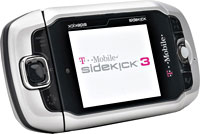 T-Mobile has finally officially announced the T-Mobile Sidekick 3, adding a new trackball controller, Bluetooth and EDGE data to the popular Sidekick 2.
T-Mobile has finally officially announced the T-Mobile Sidekick 3, adding a new trackball controller, Bluetooth and EDGE data to the popular Sidekick 2.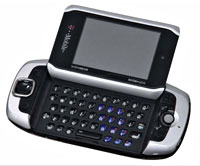 The Sidekick boasts a new 1.3 megapixel camera and assist light, with a large 65k colour, transflective TFT display supporting a rather underwhelming 240×160 pixel resolution.
The Sidekick boasts a new 1.3 megapixel camera and assist light, with a large 65k colour, transflective TFT display supporting a rather underwhelming 240×160 pixel resolution.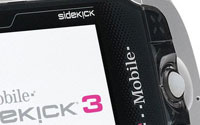 New for version three is a Bluetooth system supporting both the OBEX Push and Headset/Hands Free profiles and a mini-USB port for transferring files from a PC.
New for version three is a Bluetooth system supporting both the OBEX Push and Headset/Hands Free profiles and a mini-USB port for transferring files from a PC.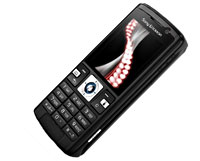 With a full blown parp on their PR trumpets, Sony Ericsson has announced its new Sony Ericsson K610im, their first GSM/UMTS handset to offer full support for i-mode.
With a full blown parp on their PR trumpets, Sony Ericsson has announced its new Sony Ericsson K610im, their first GSM/UMTS handset to offer full support for i-mode.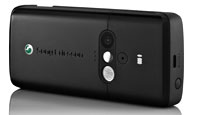 Although the download speed isn’t exactly impressive right now, the next-gen i-mode looks to be a much sleeker beast, supporting white-knuckle speeds up to 384 kbps.
Although the download speed isn’t exactly impressive right now, the next-gen i-mode looks to be a much sleeker beast, supporting white-knuckle speeds up to 384 kbps. Other features include a speakerphone, Bluetooth, USB 2.0, USB charging and a flight mode.
Other features include a speakerphone, Bluetooth, USB 2.0, USB charging and a flight mode. Imaging and messaging
Imaging and messaging